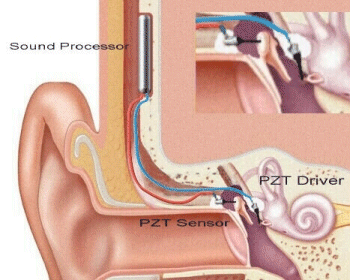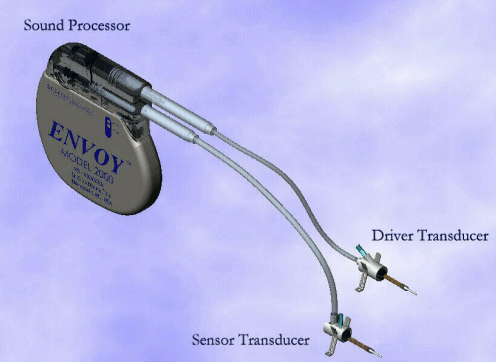
PITTSBURGH, PA -- A team of ear surgeons at Allegheny General Hospital (AGH) has become the first in the United States to use a revolutionary, completely implantable hearing restoration system that promises to greatly improve the hearing capacity of those who suffer from mild to severe sensorineural hearing deficits, the most common form of hearing loss - associated with aging or exposure to loud noise. An estimated 10 million of the 30 million Americans living with sensorineural hearing loss would be considered good candidates for the new therapy.
Pioneered by St. Croix Medical Inc., in Minneapolis, MN, the Envoy Middle Ear Implantable System has been tested in Germany for the past year and was just recently cleared by the Food and Drug Administration for study in the U.S. The Envoy technology is the only totally implantable hearing restoration system in the world and AGH is one of two U.S. medical centers that will investigate the technology in a phase one clinical trial, joining the Virginia Mason Hearing for Life Center in Seattle, Washington
The investigation is being co-directed at AGH by nationally renowned ear surgeons Moises Arriaga, M.D., and Douglas Chen, M.D., who are also co-directors of the hospital's Hearing and Balance Center.
Last week, a 66-year-old North Side man became the first person in the U.S. to receive the Envoy System, followed by three other patients, a 73-year-old man from Wabash, a 58-year-old woman from Greensburg and a 63-year-old man from Johnstown. The systems will be activated for the first time in approximately six to eight weeks after healing from the surgical procedure.
According to Arriaga, excitement over the Envoy System centers around its potential for both eliminating problems associated with conventional, externally worn hearing aids, such as background noise, acoustic feedback, ear canal occlusion and signal distortion, and its application to a large number of people whose hearing loss threshold is beyond the reach of current devices. The potential for improved sound quality with the Envoy system combined with the technology's invisibility could significantly increase the number of people who seek assistance for their hearing loss, Arriaga said. Currently, only 10-20 percent of those considered good candidates for hearing aids use them.
"For most people who suffer from sensorineural hearing loss, hearing aids can provide significant quality of life improvement. The problem with conventional devices, however, is twofold; people often don't like how they look or feel and the overall sound quality is fairly limited. Additionally, for those whose hearing loss threshold is greater than 55 decibels, conventional devices are typically ineffective, leaving us with few therapeutic options," Arriaga said.
Conventional hearing aids conduct sound using directional microphones that often pick up sound from sources other than what the user is focused on, making it difficult to understand and interpret background noise. In contrast, the Envoy System employs the body's own eardrum as its microphone, using the natural acoustics of the ear canal without obstruction, interference or any external devices. The input signals are thus identical to those received by a person with normal hearing, allowing for much better sound transmission and comprehension.
"The Envoy System clearly promises to take the field of hearing restoration to a new level and its impact could be tremendous in terms of the number of people with hearing loss who stand to benefit. The advanced design and engineering of the technology should allow us in most cases to return victims of sensorineural hearing loss to normal or very close to normal hearing levels. I believe it will become the standard by which all future hearing restoration technology is based," said Chen.
Utilizing technology and components contained in implantable cardiac pacemakers, the Envoy System employs state-of-the-art, biocompatible piezoelectric transducers to detect and reproduce sound vibrations of the middle ear bones. Two transducers, the Sensor and Driver, are mounted to the middle ear bones and connected via fatigue-resistant wires to a separate electronic unit implanted in the occipital bone behind the ear that consists of a programmable sound processor and power source.
The Sensor detects sound vibrations from the tympanic membrane through the malleus and incus bones. The system converts those vibrations into electrical signals that are amplified, filtered and transmitted as mechanical vibrations through the Driver to the stapes bone. The signal is then delivered via the stapes bone to the inner ear where it is converted into nerve impulses and translated into words or sound by the brain.
The Envoy System is powered by a pacemaker-type lithium battery with a projected life-span of approximately five years. When the battery begins to weaken, the implantable sound processor/power source can be replaced independent of the more deeply implanted transducers, a procedure that can be done on an outpatient basis under local anesthesia.
The Envoy System's electronics circuit is programmable with radio frequency telemetry and is comprised of bandpass amplifiers with frequency responses controlled via physician or audiologist programming to fit a patient's specific hearing loss profile. The system provides adjustable gain and volume control, a configuration that allows the hearing loss compensation for high frequency loss to be independent of the compensation for low frequency loss. This compression feature optimizes the device's function in changing environments, such as moving from noisy situations to quiet situations.
Patients also have the ability to remotely program the implanted system with a pocket sized programmer to adjust the volume, place the unit in standby for sleep and select one of three programmed settings, which have been individually tailored to the patient. Programmed settings can be changed at any time by the audiologist or physician to help patients adapt to the new sound or hearing performance changes.
Approximately 10 patients will be enrolled in the phase one study of the Envoy System, with an expanded phase two study to commence shortly after pending FDA approval, said Doug Hoag, spokesman for St. Croix.
Those interested in AGH's investigation of the Envoy System, can contact Drs. Chen and Arriaga at 1-877-284-2000.


